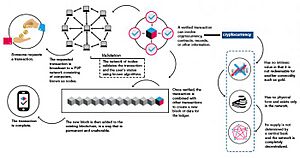Blockchain facts for kids
A Blockchain is like a super secure digital notebook. It's a chain of "blocks," and each block holds important information. Once information is put into a blockchain, it's very hard to change. This is because there isn't one main computer (or server) that controls it. Instead, the blockchain stores copies of the data on many computers at the same time. This makes it almost impossible for someone to hack in and steal or change the data.
Contents
How Blockchain Started
Blockchain technology has an interesting history.
- In 1991, two scientists named Stuart Haber and Scott Stornetta invented blockchain. They wanted a way to keep digital records accurate and safe.
- In 1995, a computer scientist named Nick Szabo thought of "bit gold." This was an idea for a currency that wasn't physical, but could be used to pay for things.
- Stefan Konst expanded on blockchain ideas in 2000. He showed how to use cryptography (secret codes) to make these chains even more secure.
A big step happened in 2008. Developers using the name Satoshi Nakamoto wrote a paper. It explained how to use blockchain. The next year, Nakamoto made it public for use with bitcoin transactions. By 2014, people started using blockchain to manage other types of secure information too.
How Blockchain Is Used
Blockchain helps make trading easier and keeps very accurate records. Here's how it generally works:
- When someone wants to make a transaction, the information is sent out. It goes to a network of computers called nodes. This is a peer-to-peer (P2P) network, meaning computers talk directly to each other.
- The network of nodes then uses special rules called algorithms. They check if the transaction and the user are real and valid.
- This validated information can include things like cryptocurrency payments. It can also include medical records, identity documents, food supply records, or even voting records.
- Once the information is checked and approved, it's added to a new block. This new block is then added to the existing chain of blocks. If it's a payment, the transaction is now complete.
- More information keeps getting added to the blockchain in the same way. This creates a very long and secure chain of data.
Benefits of Blockchain
Blockchain offers many good things for both people and companies.
- Security: No single computer (node) can add, change, or remove data on its own. If a change happens in one place, it quickly spreads across the whole network. This makes it very secure.
- Cost Efficiency: Using blockchain can lower a company's expenses. This is because there's often no middle-person or third party that needs to be paid.
- Permanence: Every single transaction or piece of information is recorded forever. It cannot be easily deleted.
- Easy Tracking: Every transaction has a clear record, like an audit trail. This makes it simple to track something back to its original source.
Images for kids
-
Blockchain panel discussion at the first IEEE Computer Society TechIgnite conference
See also
 In Spanish: Cadena de bloques para niños
In Spanish: Cadena de bloques para niños



